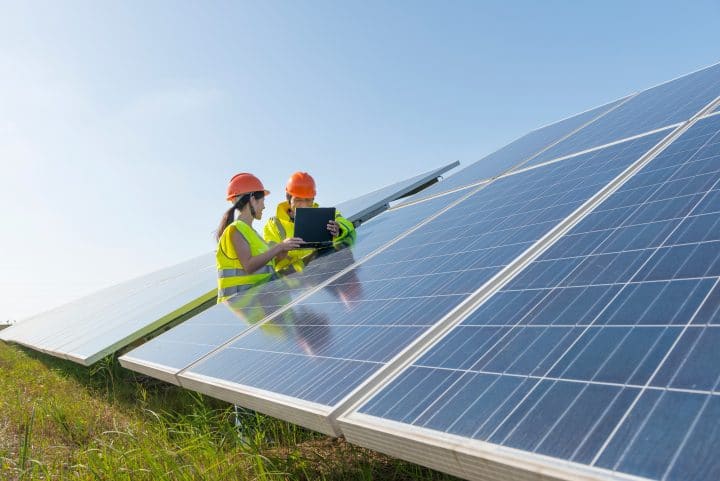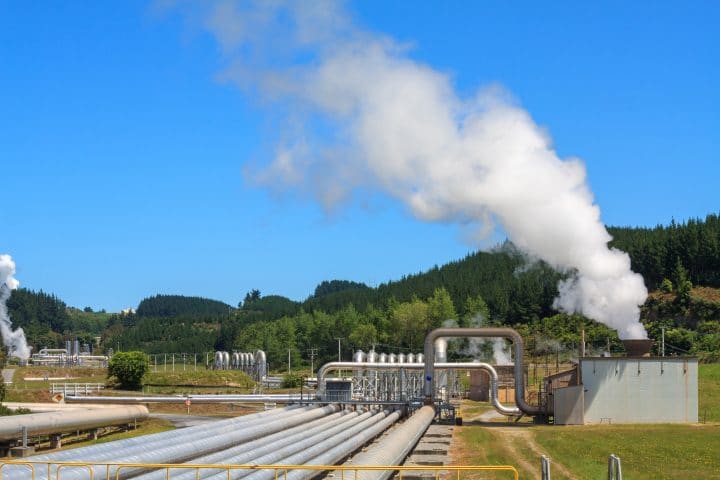According to a 2019 report by IRENA, renewable energy accounted for 2,351 GW of global energy generation capacity at the end of 2018. This a massive amount, but what makes renewables such a popular choice? In this article, we’ll address this question, taking a look at the pros and cons of renewable energy as a whole.
Pros of Renewable Energy
Let’s start by looking at the many different advantages of renewable energy sources.
1. Renewables Are Better For The Environment
Using renewables to generate power is much better for the environment than the use of fossil fuels. When we burn fossil fuels, they release harmful greenhouse gases into the atmosphere. Many scientists agree that these gases are contributing to climate change and the warming of our planet.
By using renewables to meet our current and future energy demands, we can help to reduce the effects of climate change. A reduction in air pollutants will also have a range of benefits to our health.
2. We Can Rely On Renewable Energy Sources
Natural resources such as coal, oil, and natural gas, play a key role in meeting our current energy demands. These non-renewable energy sources are a finite resource; meaning they will one day run out. Renewables, on the other hand, will never run out. We can, therefore, rely on them to provide a source of energy for as long as life is supported on earth.
3. Using Renewable Energy Conserves Natural Resources
Because natural energy resources are so important, we are unlikely to ever become fully independent of them. For this reason alone, it is important that we conserve non-renewable resources wherever possible.
Using renewable energy sources for things like electricity production, heating, and transport helps to reduce the level of natural resources we consume for these purposes. This helps to conserve supplies of coal, oil, and gas, making them available for future generations to use.
4. There Are Lots of Different Options To Choose From
One of the great things about renewables is that there are lots to choose from. You aren’t just limited to one specific energy source and can select the right fit for your needs. Some of the different types and uses of renewable energy sources include the following:
- Solar Energy – This can be used to generate power with solar cells or heat water with solar thermal technology. Solar power can be produced at both a domestic and industrial scale.
- Wind Energy – Wind turbines are often used to generate power at an industrial level. Some smaller turbines exist which are suitable for domestic uses.
- Geothermal Energy – Offers the possibility to generate power and heat water. Geothermal power plants generate electricity whereas ground source heat pumps can be used to heat domestic hot water supplies.
- Hydropower – Traditionally used to turn the water wheels of mills and factories, we mostly use this renewable energy source for power generation. It involves the use of flowing water to rotate a turbine. Water can be sourced from either a river/stream, a trapped body of water, and the sea (in the form of tidal and wave power.)
- Biomass – We can use this to generate power and create biofuel. Power can be generated from the burning of biomass and/or the anaerobic digestion of animal waste. Some traditional food crops are capable of producing biodiesel and bioethanol which can both be used in transport.
5. Renewables Can Reduce Your Energy Bills
One of the main reasons why people invest in renewable energy systems is to reduce their energy bills. Whilst the initial investment of renewable tech can be high, a reduction in energy bills can help pay for the system over its lifetime.
When you add the possibility of renewable energy grants and/or schemes like net metering in the United States and feed-in tariffs in the United Kingdom, return on investment can be accelerated. Some homeowners have been able to turn a profit by selling the excess electricity they generate back to the grid.
6. They Can Increase Energy Security
When you generate your own electricity from renewable energy sources, you are increasing your energy security. This term reflects how vulnerable either you or your country’s government might be to external influences on energy supplies.
War, sanctions, and supply/demand issues can all affect the price and availability of energy. Given the fact that nobody controls the supply of renewable energy, making use of it can increase your energy security.
7. Renewable Technology Is Often Low Maintenance
Although often complex to install, once a renewable energy system is in place it can require little maintenance. This is especially true for solar panels; after installation, they will happily sit there generating power day after day.
Whilst some maintenance will be required over time, the technology doesn’t require constant monitoring.
8. It Has Both Domestic and Industrial Uses
As we touched on in advantage #4, renewables have both domestic and industrial uses. Solar power can be generated right on top of your roof, but it can also be generated in large quantities at a solar farm. The same is true for wind turbines, but these are more likely to be contained within a wind farm.
Geothermal is another example of a renewable energy source with both domestic and industrial uses. Ground source heat pumps can help heat the water of your home whereas geothermal power plants can generate large quantities of electricity.
9. The Renewable Energy Industry Creates Jobs
It’s no secret that the renewable energy sector has created jobs. What might surprise you is the number of jobs created by the industry. According to their 2019 review of renewable energy jobs, IRENA estimates that the industry employed over 11 million people in 2018.
Although this is a global figure, 11 million is still a massive amount of jobs! The same report estimates that around 39% of all renewable energy jobs are in China. This might be no surprise considering how the country has invested so heavily in renewables over recent years.

10. It Can Provide Power To Remote Locations
Another advantage of renewable energy is the fact it has the potential to bring power to remote locations. This can help transform remote areas of some countries, bringing low-cost energy to villages and other settlements.
Remote research facilities can also benefit from renewable technology. It is often uneconomical to run power cables to such locations. The International Space Station and a plethora of communications satellites also benefit from the use of renewable energy in a remote location.
Cons of Renewable Energy
So, we’ve established that renewables have lots of benefits, but what about the disadvantages? Let’s now take a look at the drawbacks of renewable energy.
1. The Technology Can Be Expensive
Solar panels, wind turbines, and other renewable technology can be very expensive. For those on a budget, this can be the deciding factor and may result in the use of non-renewable alternatives.
2. Renewable Energy Is Often Intermittent
Most renewable energy sources suffer from the fact they are intermittent. The sun only shines during the day, the wind can fluctuate, and geothermal energy can be affected by ground temperature.
Hydropower has its own set of drawbacks in that drought can affect the availability of water, the tides come and go, and waves are influenced by the wind.
All of these drawbacks make readily available fossil fuels a tempting choice over renewable alternatives. But of course, the more we use fossil fuels, the sooner they will run out altogether.
3. Geographic Limitations Exist
If the intermittent nature of renewables wasn’t enough to put you off, take a look at the geographic limitations instead. Nearly all renewable energy sources require certain conditions to become an efficient replacement for traditional energy sources.
Solar panels are ineffective in some environments. Think shaded properties and parts of the world with lots of cloud and rain. When it comes to wind turbines, they require strong and consistent wind levels to be efficient. This is why offshore wind farms are so popular; there are fewer obstacles to reduce the intensity of the wind.
Both hydro and geothermal power also suffer from geographic limitations. Hydroelectric dams require a large body of trapped water and tidal power is only feasible in specific areas. With geothermal power, only some parts of the world have enough thermal activity near to the surface to make it viable. Some countries such as Iceland and New Zealand have used this to their advantage and generate large quantities of electricity from it.

4. Renewable Energy Is Difficult To Store
Traditional power stations have the advantage of being able to store natural resources so they can burn them on demand. However, this is not the case with all renewable energy sources.
We are unable to capture either the sun or the wind for use at a later date. Ok, we could just generate the power and charge batteries to store it, but this adds cost and requires lots of space.
It’s not all doom and gloom though. Some technologies can benefit from the storage of renewable energy. Think of how a hydroelectric dam stores water behind the dam wall. It can tap into this source of renewable energy as and when it needs to. Biomass is similar, you can store it and burn it on demand as with traditional sources of energy.
5. Renewables Can Still Cause Pollution
You might have noticed how we talk about ‘burning’ biomass in order to generate electricity. Although biomass is considered a renewable resource, it still causes pollution when we burn it.
Whilst biomass is less desirable than both solar and wind energy, it is still better for the environment than fossil fuels. As biomass grows, it absorbs carbon dioxide; something coal, oil, and gas cannot do as it is formed.
Of course, there are other environmental issues to consider when it comes to renewables. Manufacturing processes, land clearance, and the construction of renewable installations can all have a negative impact on the environment.
6. Renewable Power Plants Can Require Lots of Space
Similar to the previous drawback is the fact that renewable power plants often require lots of space. Whilst this is less true for geothermal power; solar farms, wind farms, and hydroelectric facilities all require a large amount of space to operate effectively.
Summary
As you can see, the number of benefits far outweigh the disadvantages. Renewable technologies can play a key role in helping to reduce pollution whilst meeting our future energy demands. They can even provide a return on investment over their lifetime.
On the other hand, the technology is expensive and suffers from geographic limitations. The intermittent nature of renewable energy sources is another key drawback that you should take into account.
Further Reading
If you are interested, we have produced different articles weighing up the pros and cons of specific renewable energy sources. For your convenience, we have listed these below: